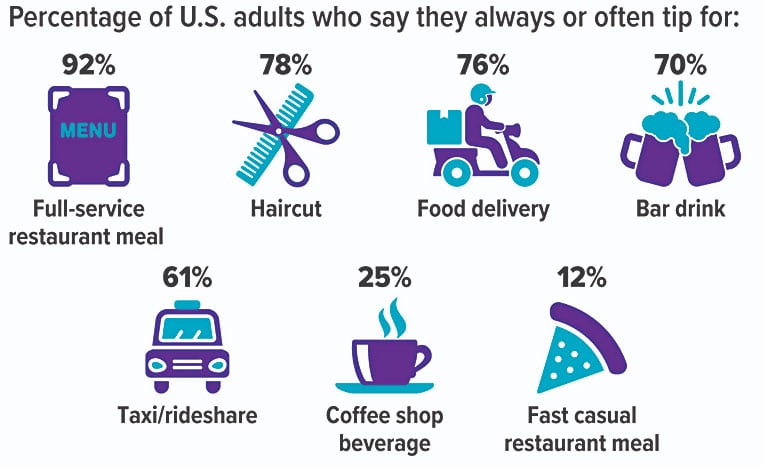Traditionally, tipping has been a way to reward workers for providing good service. But the norms around tipping are changing, and if you’ve recently felt more pressure to tip, you’re not alone. A survey by the Pew Research Center found that 72% of adults said that tipping was expected in more places today than it was five years ago, a phenomenon known as “tip creep” or “tipflation.” 1
Why tipping culture is changing
Tipping affects everyone (even tipped workers have to tip others!) and confusion and complaints about tipping abound. If you’re among those feeling uneasy about tipping, blame the pandemic. That’s when tipping culture started to change. Consumers, anxious to reward front-line workers and support struggling businesses, left more and bigger tips. Businesses adopted digital ordering and payment solutions that made tipping more convenient and could be programmed with preset tip suggestions that were often higher than customers were used to.
And then inflation took its toll. Businesses that lost employees during the pandemic increasingly realized that tips could help fill wage gaps and attract employees reluctant to return to service positions. But consumers, already having to make their money go further, began to grow weary of seemingly constant tip requests, especially in situations or places where they had not previously been asked to tip.
To Tip or Not to Tip?

Source: Pew Research Center, 2023
Tipping guidelines
Tipping often feels good, but the pressure to tip can be guilt-provoking and confusing. When a worker turns a screen around and you’re prompted to choose a preset tip, it can feel wrong to choose the lowest option. While you might always tip your server at a sit-down restaurant, in situations where you’ve had little to no direct interaction with any employee, should you even tip at all?
Ultimately, tipping is always voluntary and it’s up to you to decide who, where, and how much to tip. While there are no set rules, here are some guidelines you can use to inform your decisions.2
-
-
- Full-service restaurant or food delivery: 20% of total bill
- Quick service restaurant: 10%
- Online food orders/takeout: $1 to $5 per order
- Bar or coffee shop: $1 to $2
- Hotel bellstaff: $1 to $5 per bag
- Hotel housekeeping: $1 to $5 per night
- Valet/parking attendant: $1 to $5 when car is delivered
- Rideshare/taxi driver: 15% to 20% of the fare
-
Finding a balance
Planning ahead can help you avoid some of the frustration around tipping and still tip fairly and appropriately.
Do an informal audit. How much have you spent on tips during the last month or two? Does that align with your budget?
Set tipping limits you’re comfortable with. You can always make adjustments at the register.
Reserve higher tips for special situations. This might be rewarding a worker at your favorite coffee shop, or showing your appreciation when someone provides extra-special service.
Don’t feel bound by on-screen tip recommendations. Use the “custom” tip option when available to leave the amount you want.
Carry small bills. These can be used in traditional tip jars, or when traveling, to reward workers who don’t have access to digital tips.
Talk to the manager or business owner if you have questions or complaints. It’s not always clear where your tips are going (for example at fast-casual restaurants or when ordering online), so feel free to ask. And reserve your complaints about tipping expectations for management, rather than workers.
Respect policies. While many businesses encourage tipping, some do not allow their employees to accept tips for legal reasons. Instead, consider leaving positive feedback.
If you have questions or need assistance, contact the Experts at Henssler Financial:
- Experts Request Form
- Email: experts@henssler.com
- Phone: 770-429-9166








